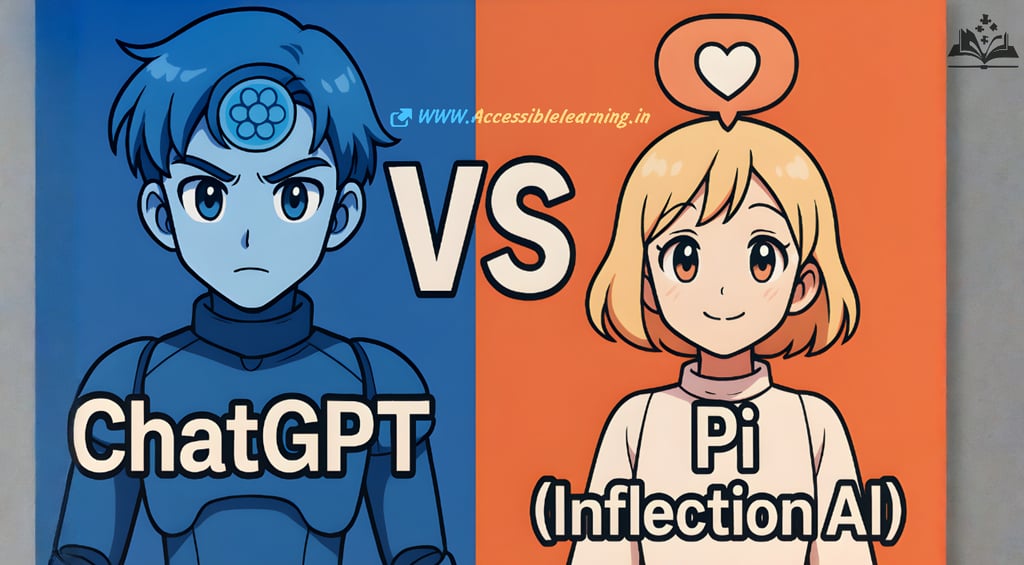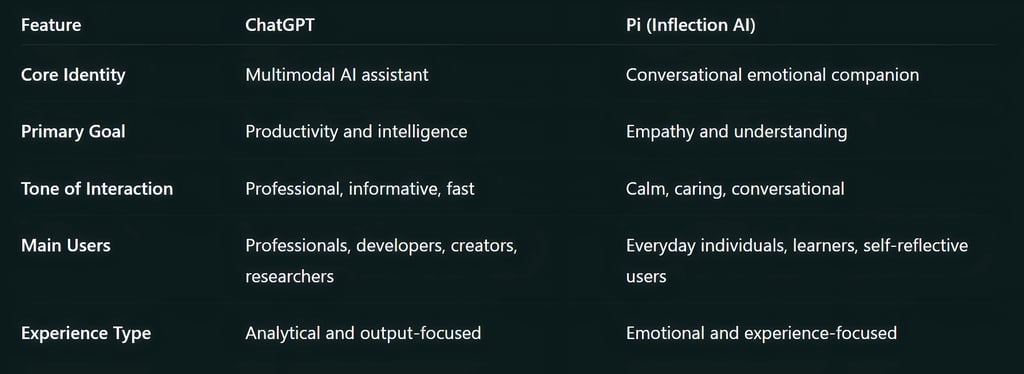
ChatGPT vs Pi (Inflection AI): The Evolution of Conversational Intelligence
ChatGPT vs Pi (Inflection AI): Discover how OpenAI’s powerful multitasking assistant compares to Inflection AI’s emotionally intelligent companion. Learn their features, differences, technologies, and real-world uses — from coding and creativity to mindfulness and everyday conversation.
AI ASSISTANTA LEARNINGAI/FUTUREEDITOR/TOOLS
Sachin K Chaurasiya
11/13/20258 min read


Artificial Intelligence has moved from automation to companionship. Today, AI assistants don’t just perform tasks; they listen, reason, and even care how you feel. Two leaders shaping this transformation are ChatGPT from OpenAI and Pi from Inflection AI.
Both redefine human-AI communication, but they represent two very different philosophies:
ChatGPT is built for power and productivity, while Pi is built for empathy and presence.
Let’s dive deep into their differences, technologies, and impact and find out which one truly fits your world.
Origins and Philosophy
ChatGPT The Universal Problem Solver
Developed by OpenAI, ChatGPT is powered by the GPT (Generative Pre-trained Transformer) series models trained on massive datasets of text, code, and dialogue. Its purpose is to understand, generate, and reason across a wide range of topics.
The current top-tier model, GPT-4o, integrates text, vision, and audio seamlessly.
OpenAI’s mission focuses on “aligning artificial general intelligence (AGI) with human values.”
ChatGPT is designed for scalability, from personal use to enterprise-level solutions.
It’s the Swiss Army knife of AI versatile, precise, and task-oriented.
Pi: The Personal Intelligence
Inflection AI, co-founded by Mustafa Suleyman (ex-DeepMind) and Reid Hoffman (LinkedIn co-founder), created Pi as a “Personal AI,” short for Personal Intelligence.
Unlike traditional assistants that focus on productivity, Pi’s design centers on emotional depth.
Its goals:
To build an AI that understands human emotions.
To encourage reflection, growth, and calm conversation.
To make AI a trusted daily companion, not just a tool.
Pi’s tone is human, caring, and balanced — it feels more like talking to a friend than a chatbot.



Interface and User Experience
ChatGPT Experience
ChatGPT is designed like a workspace neat, functional, and efficient.
Offers text, voice, and image input (in GPT-4o).
Supports file uploads, code interpretation, and data analysis.
Enables Custom GPTs that tailor behavior for specific use cases (e.g., SEO, law, coding).
The interface supports multiple projects and memory for personalized continuity.
It’s fast, professional, and ideal for people who use AI as an extension of their work.
Pi Experience
Pi’s interface feels like a personal chat app with soft colors, gentle language, and natural pacing.
Conversations are designed to be supportive and free of jargon.
It remembers tone and intent within sessions, helping maintain emotional context.
Available via mobile apps, web browsers, and voice calls.
Pi often replies with questions that encourage self-discovery, almost like a coach or counselor.
Where ChatGPT solves problems, Pi helps you explore them.
Technological Backbone
ChatGPT’s Technology
Based on transformer architecture developed by OpenAI.
Current model: GPT-4o, a multimodal successor to GPT-4, integrating text, audio, and image understanding.
Uses Reinforcement Learning from Human Feedback (RLHF) to align responses with human expectations.
Continuously fine-tuned for reasoning, factual accuracy, and creativity.
Integrated with OpenAI’s API ecosystem and available across ChatGPT Free, Plus, Team, and Enterprise tiers.
In short, ChatGPT is a multi-domain intelligence engine capable of handling complex logic and creativity at once.
Pi’s Technology
Powered by Inflection AI’s proprietary Inflection-2 model, trained on conversational data.
Built using large-scale transformer networks optimized for empathetic dialogue.
Designed to interpret emotional cues and language tone.
Prioritizes safe, ethical conversation design, steering away from aggression, misinformation, or negativity.
Includes human feedback loops that improve personality and conversational flow.
Pi’s model isn’t about technical complexity; it’s about human connection accuracy and understanding how to talk, listen, and comfort.
Feature Highlights
ChatGPT Highlights
Multimodal Input: Text, image, and voice understanding.
Code and Math: Exceptional for debugging, algorithms, and structured analysis.
Custom GPTs: Create your own specialized assistant.
Data Analysis: Interpret Excel, CSV, and PDF files.
Image Generation: Integrated with DALL·E 3 for creative visuals.
Team and Enterprise Tools: Centralized admin controls, shared memory, and data governance.
Pi Highlights
Conversational Depth: Feels like chatting with a therapist or life coach.
Voice Integration: Calm, natural speech-to-text experience.
Wellness-Centered: Encourages mental clarity and emotional balance.
Human Tone Modeling: Every response is crafted to be kind, patient, and human-like.
Cross-Device Syncing: Continuity across phone, tablet, and desktop.
Data Sensitivity: Prioritizes private, non-judgmental interactions.
Personality and Communication Style
ChatGPT is a polymath; it can be a scientist, poet, developer, or strategist, depending on how you prompt it.
Pi is an emotional anchor; it keeps a consistent, warm tone designed to reduce anxiety and increase focus.
If ChatGPT is a virtual mentor, Pi is a gentle companion.
ChatGPT teaches you what to do next.
Pi reminds you why you’re doing it.
Accessibility and Availability
ChatGPT is available globally via web, iOS, Android, and desktop app.
Free version uses GPT-3.5; the Plus version unlocks GPT-4o.
Enterprise and Team plans unlock more features and privacy controls.
Pi is available via pi.ai, iOS and Android apps, and even voice integration.
It’s free to use for most users, with expanding availability.
Offers simple onboarding with no setup; just chat and connect.
Data Privacy and Ethical Use
OpenAI allows Enterprise and Team customers to opt out of data training, ensuring privacy for businesses.
Inflection AI emphasizes personal trust Pi doesn’t market or sell user data and avoids AI “profiling.”
Both companies have public AI ethics and transparency policies, though OpenAI focuses on broad AI safety, while Inflection focuses on user emotional well-being.
Real-World Impact
ChatGPT in Action
Used in education, journalism, software development, healthcare, and design.
Powers automated research, chatbots, creative tools, and AI applications.
Businesses use it to save hours of manual work through custom GPT workflows.
Pi in Action
Used by students, professionals, and everyday users for reflection and guidance.
Acts as a safe conversational space to manage stress, talk through goals, or brainstorm gently.
Often integrated into mindfulness and digital wellness routines.



Both ChatGPT and Pi show how AI is no longer just smart; it’s human-aware.
OpenAI teaches machines to think like us.
Inflection AI teaches them to feel like us.
The future of AI lies at the intersection of both, where power meets empathy.
When intelligence becomes emotional, and emotion becomes intelligent that’s when AI truly becomes human-centered.
In short
ChatGPT is your digital co-worker.
Pi is your digital companion.
And together, they mark the next chapter in the story of intelligent, emotional technology.
FAQs
Q: What is the main difference between ChatGPT and Pi (Inflection AI)?
The main difference lies in purpose and personality. ChatGPT is designed for productivity writing, coding, research, and creative tasks, while Pi focuses on emotional intelligence, offering gentle, reflective, and human-like conversations. ChatGPT is a multitasker, while Pi is a listener.
Q: Who created ChatGPT and Pi?
ChatGPT was developed by OpenAI, a U.S.-based artificial intelligence company known for creating large-scale language models like GPT-4 and GPT-4o.
Pi was developed by Inflection AI, co-founded by Mustafa Suleyman (DeepMind co-founder) and Reid Hoffman (LinkedIn co-founder).
Q: Which AI is better for professional use?
For professional, academic, and business use, ChatGPT is the better option. It can handle reports, coding, marketing content, research summaries, and image generation. Pi is more suited for personal reflection, conversation, or mental wellness support.
Q: Can Pi perform tasks like coding or data analysis?
No. Pi is not built for technical or data-driven tasks. It focuses on emotional support, life planning, and thoughtful conversation. If you need advanced computation, content creation, or development help, ChatGPT is the right choice.
Q: Is ChatGPT more powerful than Pi?
Yes, in terms of computational power and reasoning, ChatGPT is far more capable. It’s trained on vast datasets, can generate structured output, and supports multimodal inputs (text, voice, and image).
However, Pi’s strength is in human-like empathy and tone, not technical output.
Q: Can both ChatGPT and Pi talk through voice?
Yes, Both support voice conversations, but they feel different:
ChatGPT’s voice mode (available in GPT-4o) feels professional and responsive.
Pi’s voice mode feels natural, soothing, and emotionally expressive, like a calm conversation partner.
Q: Is Pi available for free?
Yes, Pi (Personal Intelligence) is currently free to use via pi.ai and mobile apps (iOS and Android).
Some advanced or premium features may be introduced later, but the core experience remains free and accessible.
Q: How private are ChatGPT and Pi?
Both emphasize user privacy but handle it differently:
ChatGPT (Team, Enterprise, and Pro) offers strict data privacy; your chats are not used to train AI models.
Pi emphasizes emotional privacy, ensuring personal conversations remain safe, anonymous, and non-judgmental.
For sensitive or business data, ChatGPT’s enterprise plans provide more formal data governance.
Q: Can I integrate ChatGPT or Pi with my business tools?
Yes, but only with ChatGPT.
ChatGPT supports API integration, Custom GPTs, and workflow automation, making it useful for businesses, developers, and startups.
Pi, however, does not offer open APIs or integrations, yet it’s designed for direct, personal chat experiences.
Q: Which one is better for emotional well-being?
Pi is designed with emotional well-being in mind. It uses a gentle tone, empathetic responses, and supportive conversation to help users manage stress and find clarity.
ChatGPT can assist with mental wellness topics, but it’s not emotionally adaptive like Pi.
Q: Do ChatGPT and Pi use the same type of AI model?
No.
ChatGPT uses GPT-4o (OpenAI’s multimodal model).
Pi uses Inflection-2, a proprietary large language model by Inflection AI optimized for natural, emotionally resonant dialogue.
Q: Which one understands human emotions better?
Pi is intentionally trained for empathy. Its core design focuses on understanding tone, pacing, and emotional context.
ChatGPT recognizes emotional cues but remains objective; its focus is clarity and accuracy rather than emotional depth.
Q: Can ChatGPT and Pi generate images or creative visuals?
Only ChatGPT can generate images.
It includes DALL·E 3 integration, allowing users to create AI art, thumbnails, and concept designs directly in chat.
Pi does not have image generation or visual creation features.
Q: Are these AI tools available on mobile devices?
Yes
ChatGPT is available on iOS, Android, and desktop (via browser and app).
Pi is also available on mobile (iOS, Android) and web, optimized for simple, clean chat interaction.
Q: Can both AIs remember previous conversations?
Partially.
ChatGPT (with memory features enabled) can retain facts, preferences, and user details to personalize future chats.
Pi maintains short-term context within active sessions, focusing on emotional continuity rather than long-term memory.
Q: Which one is better for learning or study help?
Both can help, but differently:
ChatGPT can teach subjects, explain concepts, and summarize textbooks.
Pi can motivate, keep you accountable, and help you plan study schedules in a friendlier way.
For academic performance, choose ChatGPT.
For encouragement and focus, choose Pi.
Q: Is there any link between OpenAI and Inflection AI?
In 2024, Microsoft hired key members from Inflection AI and licensed some of its technology, which blurred lines between the two ecosystems.
However, ChatGPT and Pi remain separate products, developed and managed independently by their respective companies.
Q: Which one is more human-like?
Pi feels more human in tone and emotion, while ChatGPT feels more human in intelligence and reasoning.
If you want empathy and warmth, Pi wins.
If you want insight and accuracy, ChatGPT wins.
Q: Can both AIs be used offline?
No, Both ChatGPT and Pi require an internet connection to process input and generate responses, as their models run on remote servers.
Q: What does the future hold for ChatGPT and Pi?
The next evolution of AI will likely merge both concepts: ChatGPT’s reasoning and Pi’s empathy.
OpenAI continues expanding multimodal intelligence, while Inflection AI focuses on emotional depth and voice interaction. Soon, we might see AI companions that can both think deeply and feel authentically.
Subscribe to our newsletter
All © Copyright reserved by Accessible-Learning
| Terms & Conditions
Knowledge is power. Learn with Us. 📚


